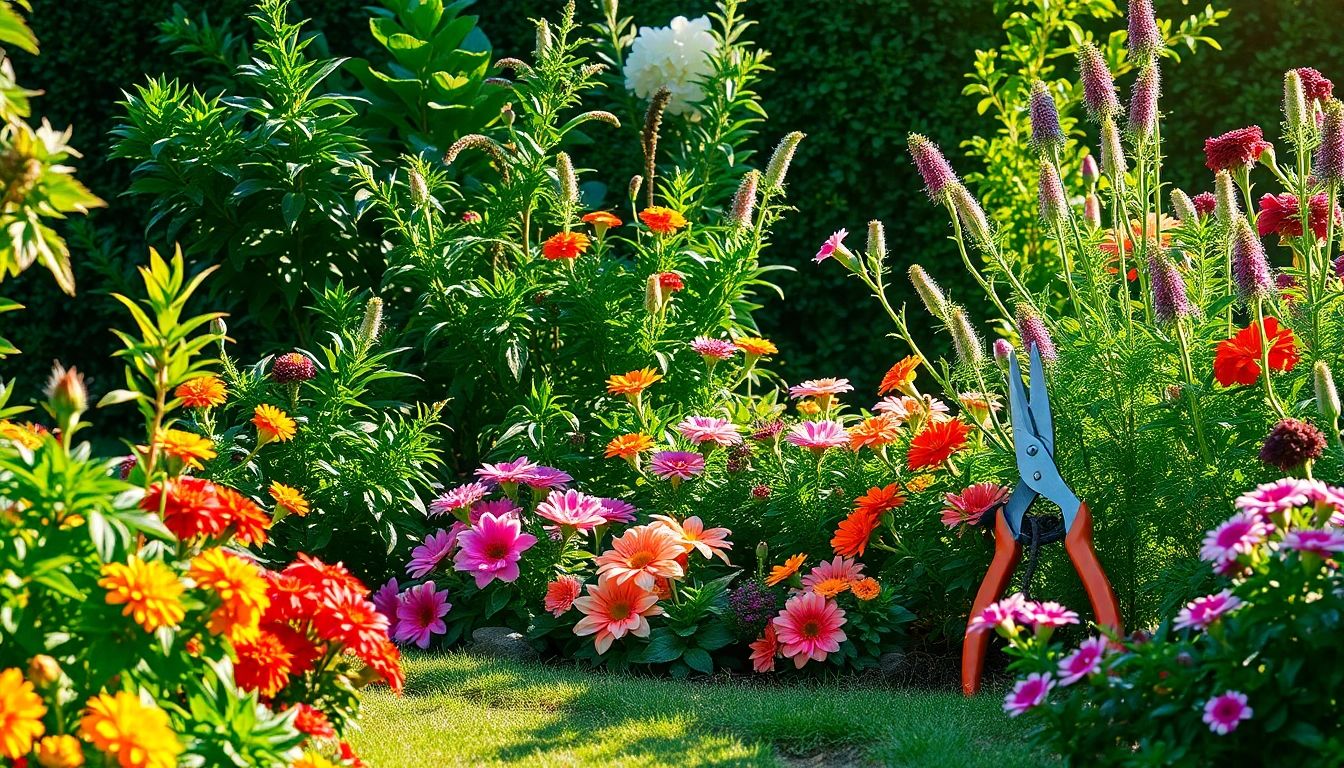Understanding Garden Maintenance Services
What is Garden Maintenance?
Garden maintenance encompasses a variety of activities designed to keep a garden looking its best throughout the seasons. This includes routine tasks such as mowing, weeding, pruning, planting, and pest control. The aim is to create a healthy, thriving outdoor environment that promotes not only aesthetic beauty but also ecological balance. An effective garden maintenance service will address the unique needs of each garden space while ensuring that plants receive the appropriate care they require based on species, growth stage, and seasonal changes.
Benefits of Professional Services
Utilizing professional garden maintenance services offers numerous advantages. First and foremost, it saves time—a precious resource in our busy lives. Professionals are adept at efficiently handling tasks that may take amateur gardeners significantly longer. Additionally, these services often employ specialists who possess extensive knowledge of horticulture, pest management, and soil science, ensuring the highest level of care.
Moreover, a well-maintained garden can enhance property value, boost curb appeal, and create an inviting atmosphere for family and guests. Another critical aspect is the creation of a sustainable environment, where professionals can implement eco-friendly practices and recommend native plants that support local wildlife.
Key Tasks Involved in Maintenance
Garden maintenance isn’t one-size-fits-all; it encompasses a range of tasks tailored to the specific requirements of different gardens. Some of the key tasks include:
- Lawn Care: Regular mowing, aeration, and fertilization to keep grass healthy and lush.
- Soil Management: Testing and amending soil to ensure optimal conditions for plant growth.
- Pruning and Trimming: Removing dead or overgrown branches to promote healthy plant development.
- Weeding: Keeping unwanted plants at bay to reduce competition for nutrients.
- Pest Management: Monitoring and controlling pest populations through both chemical and organic methods.
- Seasonal Preparation: Activities such as mulching, planting, and preparation for winter or spring to ensure the garden thrives year-round.
Choosing the Right Garden Maintenance Service
Factors to Consider When Selecting a Service
Selecting a garden maintenance service can be overwhelming, given the numerous options available. Key factors to consider include the provider’s experience, reputation, and qualifications. Reading reviews and testimonials can provide insights into the quality of their services. Additionally, it’s beneficial to determine whether the service offers customized solutions tailored to the specific needs of your garden.
Furthermore, consider whether the service employs environmentally sustainable practices, especially if you’re interested in creating a wildlife-friendly garden. It’s also essential to evaluate the types of services offered, ensuring they match your maintenance needs, whether that includes regular upkeep or seasonal preparation.
Questions to Ask Potential Providers
When interviewing potential garden maintenance providers, asking the right questions can help ensure you make an informed decision. Key inquiries include:
- What specific services do you offer?
- Can you provide references from previous clients?
- How do you handle pest management, and what products do you use?
- What is your approach to sustainable gardening practices?
- How do you tailor your maintenance schedules to seasonal needs?
- Are you insured and licensed?
Understanding Pricing Structures
Pricing for garden maintenance services can vary widely based on several factors, including the size of the garden, the complexity of the services required, and the service provider’s experience. Typically, maintenance services may charge either a flat fee for specific tasks or an hourly rate. Some may offer packages that include a variety of services at a reduced cost.
It’s wise to obtain detailed quotes from multiple providers to compare prices while also evaluating the quality of services offered. Understanding what is included in the price—for instance, materials like mulch or fertilizer—can help clarify the overall expense and prevent unexpected costs.
Common Challenges in Garden Maintenance
Pests and Diseases: Prevention and Management
Pests and plant diseases pose significant challenges for maintaining a healthy garden. Effective prevention begins with understanding potential threats and monitoring plants regularly for early signs of distress. Implementing integrated pest management (IPM) strategies, which incorporate cultural, physical, biological, and chemical methods, can help mitigate these issues efficiently.
For example, introducing beneficial insects, such as ladybugs and lacewings, can provide natural pest control and reduce reliance on chemical solutions. Regularly inspecting for signs of disease, such as yellowing leaves or unusual spots, allows for prompt treatment, fostering a healthier garden environment.
Seasonal Changes and Their Impact on Gardens
Each season brings unique challenges and opportunities for garden maintenance. In spring, proper planting techniques and soil preparation help set the foundation for a thriving garden. Summer demands regular watering and pest management to combat heat stress, while autumn calls for strategic plant selection to ensure a robust garden that can withstand winter temperatures.
Additionally, understanding local climate conditions can significantly enhance garden health. For example, knowing the frost dates and adjusting planting schedules accordingly can prevent damage to young plants, ensuring a vibrant display come blooming season.
Time Management for Busy Gardeners
With increasingly busy lifestyles, many gardeners struggle to find time for upkeep. Creating a maintenance schedule can streamline tasks and ensure that they are completed efficiently. Prioritizing task lists and employing time-saving tools, such as self-watering planters or mulching mowers, can significantly reduce the time required for maintenance.
Utilizing professional services can also alleviate time constraints, allowing gardeners more time to enjoy their spaces rather than laboring over them. Investing in garden technology—like smart irrigation systems—can further simplify maintenance by automating watering schedules based on real-time weather data.
Best Practices for Garden Care
Seasonal Tasks for Optimal Garden Health
Adhering to seasonal tasks is crucial for maintaining garden health. Each season brings specific responsibilities:
- Spring: Soil testing, planting, and fertilization.
- Summer: Regular watering, deadheading flowers, and pest monitoring.
- Autumn: Harvesting, mulching, and preparing beds for winter.
- Winter: Protecting delicate plants, planning for the upcoming season, and maintaining tools.
Implementing these seasonal best practices can promote robust plant growth and reduce the prevalence of garden problems.
Using Eco-Friendly Practices in Maintenance
As environmental consciousness continues to rise, adopting eco-friendly practices in garden maintenance becomes increasingly important. This includes using organic fertilizers and pesticides, implementing water-saving irrigation methods, and choosing native plants that thrive in local conditions without the need for excessive inputs.
Composting is another effective strategy, turning kitchen scraps and yard waste into nutrient-rich organic matter that improves soil health. Employing these sustainable practices not only benefits the garden but also conserves resources and protects local ecosystems.
Innovative Tools to Enhance Efficiency
Advancements in gardening tools and technologies have transformed how maintenance is performed. Innovative tools—from ergonomic hand tools to automated robotic mowers—can significantly enhance efficiency and reduce physical strain. Some notable tools include:
- Smart Watering Systems: Equipped with sensors and timers, these systems ensure that plants receive the right amount of water based on environmental conditions.
- Electric Tools: Lightweight electric trimmers and blowers can make maintenance tasks easier than traditional gasoline-powered tools.
- Garden Design Apps: These applications allow gardeners to plan layouts, select plants, and even visualize elements before committing to purchases.
Incorporating these tools into maintenance routines not only makes the process more enjoyable but also promotes better garden health.
Measuring the Success of Your Garden Maintenance Service
Identifying Key Performance Indicators
A successful garden maintenance service should be measurable against specific performance indicators. These may include the overall health and vitality of plants, reduction in pest populations, and the aesthetic quality of the garden. Tracking seasonal growth patterns, bloom times, and the resilience of plants to climate conditions can provide valuable data for assessing the effectiveness of provided services.
Additionally, evaluating customer satisfaction through feedback surveys can indicate how well the service meets client expectations and identifies areas for improvement.
Making Adjustments for Continuous Improvement
Continuous improvement is essential in garden maintenance, allowing services to adapt to changing environmental conditions and client needs. This can include analyzing performance data to refine pest management strategies, adjusting fertilization schedules based on soil health, or incorporating new eco-friendly practices into the maintenance routine.
Regular reviews of gardening techniques and listening to client feedback helps providers enhance the quality of care offered, ensuring sustainable and successful outcomes for gardens.
Client Testimonials: Gauging Satisfaction
Client testimonials serve as a vital tool for evaluating the success of garden maintenance services. Positive reviews can build trust with potential clients and underscore the effectiveness of the services offered. Engaging current clients in sharing their experiences not only promotes a sense of community but also allows providers to showcase their strengths.
Moreover, analyzing negative feedback can yield insights into areas where improvements are needed, fostering a culture of accountability and excellence. Collecting testimonials through structured methods—such as post-service surveys or follow-up calls—can help ensure meaningful responses that reflect true client satisfaction.



